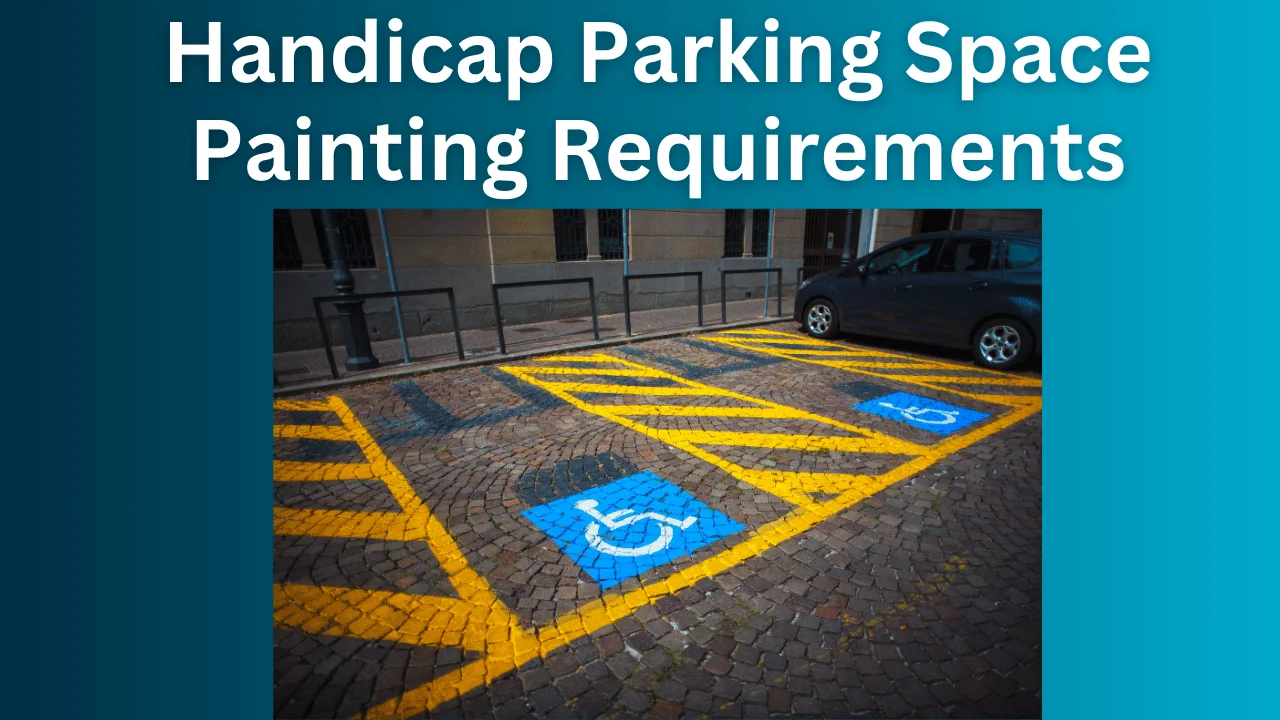In order to make cities more accessible for people with disabilities, handicap parking spaces have become an integral part of contemporary city planning. More than just a convenience, these parking spots are an act of equality that will help those who have trouble getting around use the facilities more freely. The Americans with Disabilities Act (ADA) and other regulations place stringent requirements on the correct marking and painting of these areas. In addition to protecting ourselves from legal action, we are doing our part to affirm the worth and autonomy of every person who could use these areas by making sure everyone follows these rules.
Purpose and Importance of ADA Compliance
ADA Compliance for Handicap Parking
Accessible and clearly marked parking spaces for people with disabilities are a fundamental requirement of the Americans with Disabilities Act (ADA). The requirements have been carefully crafted to meet the unique needs of this population, ensuring that building entrances are closer and that wheelchairs and other mobility aids have plenty of room to maneuver.
Accessible Parking Space Dimensions
For handicap parking spaces to be considered ADA compliant, they must meet certain dimensions. Typically, these areas need to be at least 96 inches wide for cars, with an additional 60 inches for an access aisle. Standard widths for vans are 132 inches or 96 inches, with an additional 96 inches needed for the access aisle. People who use wheelchairs or other mobility aids will have plenty of room to enter and exit their vehicles, thanks to the design.
Handicap Parking Signage Requirements
Parking spaces designated for people with disabilities must be clearly marked with signs. The blue and white International Symbol of Accessibility must be displayed in every area. Spaces that can be accessed by vans must have extra signage that clearly indicates their special status. For the sake of both drivers and pedestrians, these signs need to be 60 inches or higher from the ground.
Blue and White Accessibility Symbols
A universal signifier of accessibility, the blue and white International Symbol of Accessibility is more than just a marker. To guarantee quick identification, this symbol must be displayed prominently in each handicap parking space and on any signage that goes along with it. Those in need will be able to find their way to the designated areas with ease thanks to the design and color contrast.
Directions for Parking Vans
Parking spaces that are suitable for vans fall under the category of handicap parking and necessitate even more particular amenities. To accommodate the larger dimensions and accessibility needs of vans that transport individuals with disabilities, these areas typically require extra signage and, in some cases, even different surface treatments.
Access Aisle Requirements for Disabled Parking
When it comes to handicap parking spaces, the access aisle is absolutely crucial. Those who use mobility aids or who use wheelchairs will appreciate this additional space next to the parking spot. Aisles must be stable, level, and slip-resistant; furthermore, they must not have a slope of more than 2.08% in any direction.
Designing and Maintaining Handicap Parking Spaces
Slope Specifications for Accessible Parking
It is crucial to regulate the slope of handicap parking spaces and access aisles to ensure their continued usability and safety. No direction of a slope greater than 2.08% is required by the Americans with Disabilities Act. This standard makes sure that people who have trouble moving around won’t have any more trouble getting in and out of their cars.
Enforcement of Handicap Parking Regulations
It is not enough to merely adhere to handicap parking regulations in terms of design; enforcement is also crucial. Proper use of these areas and the enforcement of appropriate penalties for infractions are the responsibility of local authorities. This regulation helps keep the areas available for people who actually need them by discouraging their abuse.
Location Criteria for Handicap Parking Spaces
It is critical to carefully consider the location of handicap parking spots. These areas should be located as near as possible to accessible building entrances and exits so that people with disabilities don’t have far to go. These spots should be located close to elevators or ramps in multi-story parking garages so that people can easily go to different floors.
Maintenance of Accessible Parking Markings
The markings and signage for handicap parking spaces must be regularly maintained to ensure they remain visible and functional. These markings are susceptible to deterioration over time due to elements like weather and wear and tear, which can make them less noticeable and increase the risk of misuse or confusion. The spaces can be audited and inspected on a regular basis to make sure they are still compliant and are working as intended.
Role of Local Authorities in Enforcing ADA Parking Standards
A large part of the responsibility for enforcing ADA regulations regarding handicap parking falls on local governments. By conducting routine inspections, addressing complaints, and enforcing penalties for infractions, these authorities guarantee compliance with the ADA’s requirements, preserving the integrity and functionality of handicap parking spaces.
Strategies for Preventing Unauthorized Use of Handicap Parking
Effective Signage and Communication
Signage that is both legible and effective is vital in preventing the illegal use of handicap parking spaces. The International Symbol of Accessibility and details regarding consequences for abuse should both be included on signs. Additionally, educational materials and public awareness campaigns can be useful tools in conveying the significance of these areas and the repercussions of their inappropriate use to the general population.
Surveillance and Monitoring Techniques
The illegal utilisation of handicap parking spaces can be greatly reduced with the help of monitoring and surveillance systems. Some examples of this technology in action include surveillance cameras, routine patrols by parking enforcement officers, and citizen-reporting apps for mobile devices. These steps make everyone feel responsible and make it easier to find and fix infractions fast.
Collaboration with Local Law Enforcement
To make handicap parking regulations more effective, it is recommended to collaborate with local law enforcement. Officers tasked with enforcing parking regulations can be better trained to spot infractions and apply fines. Any abuse of these vital parking spots will be met with a consistent and strong response thanks to this collaboration.
Community Involvement and Education
One effective strategy for reducing instances of handicap parking space abuse is public education campaigns that target the general public. The rights of people with disabilities can be more widely respected through workshops, school programs, and PSAs. More accessible parking and public awareness of these people’s struggles can help communities become more welcoming places to live.
Best Practices for Maintaining Visibility in Handicap Parking Areas
Regular Repainting and Maintenance
Regular painting and maintenance are essential to keep handicap parking spaces visible. When exposed to the elements or simply worn down, the blue and white accessibility symbols and striping can gradually lose some of their luster. To keep them visible and in accordance with ADA regulations, it is recommended to set a maintenance schedule for painting these markings.
Use of Durable Materials
The visibility features in handicap parking areas can last longer if the paint and signage are made of durable materials. In order to maintain constant compliance with visibility standards and reduce the frequency of required maintenance, it is recommended to use high-quality paints and reflective materials. These materials can withstand weather and traffic wear better than standard materials.
Incorporating Lighting Solutions
Particularly at night or in dimly lit places, handicap parking spaces can be better seen with the help of adequate lighting. Lights strategically placed to illuminate pavement markings and signs can aid in the rapid identification of these areas and decrease the likelihood of accidental misuse.
Landscape and Environmental Considerations
The accessibility of handicap parking spaces can also be affected by the upkeep of the surrounding environment and landscape. No signs or markings should be blocked by trees, bushes, or anything else. These vital navigational aids are kept unobstructed and easily visible to everyone who needs them by regular landscaping.
Frequently Asked Questions
What are the minimum dimensions for an ADA-compliant handicap parking space?
For cars, ADA-compliant handicap parking spaces must be at least 96 inches wide with a 60-inch wide access aisle. For vans, the space must be at least 132 inches wide or 96 inches with a 96-inch wide access aisle.
How high must handicap parking signs be mounted?
Handicap parking signs must be mounted at least 60 inches above the ground to ensure visibility for all drivers and pedestrians.
What is the significance of the blue and white accessibility symbol?
The blue and white accessibility symbol is the International Symbol of Accessibility, used worldwide to indicate spaces, services, and facilities that are accessible to individuals with disabilities.
How often should handicap parking spaces be repainted?
The frequency of repainting depends on usage and environmental conditions, but generally, spaces should be assessed and potentially repainted annually or biennially to maintain visibility and compliance.
What actions can be taken against unauthorized use of handicap parking spaces?
Violations can lead to significant fines, and in some jurisdictions, vehicles may be towed. Local law enforcement and parking authorities are responsible for enforcing these regulations.
Also Read: How many Yards does a Concrete Truck Hold?
Conclusion
It is not only the law that requires you to know and follow the rules for painting handicap parking spaces; doing so is also your moral and social duty and will benefit the community as a whole. We can make sure these spaces are used for what they’re meant for: accessible and convenient parking for people with disabilities—by following ADA guidelines, keeping signs visible, and actively preventing misuse. Our communities will be more accommodating and welcoming to everyone as a result of this endeavor, which reflects a larger dedication to equality and inclusion.

Shannon Reyes is a seasoned writer with a knack for crafting engaging blogs on a variety of service industries, including plumbing, cleansing, moving, pest control, and roofing. With a keen eye for detail and a passion for helping readers navigate complex topics, Shannon brings her expertise to life through informative and accessible content.










